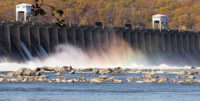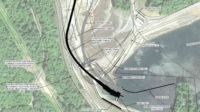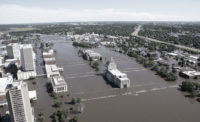Work to stabilize Iraq’s endangered 113-m-tall Mosul dam on the Tigris River will require unprecedented engineering effort, warns a Swedish-based soil-mechanic professor with extensive knowledge of the troubled site.
Faced with warnings of an imminent, catastrophic collapse of the earthfill structure causing widespread devastation, the Iraqi Ministry of Water Resources on March 2 signed up Italy’s Trevi Group to stem leaks under the dam and repair a bottom outlet floodgate.
Work will involve “an intense level of drilling activities and injection of cement mixtures” to consolidate the foundations, according to Trevi. Nearby Italian armed forces “will ensure the safety of the more than 450 technicians,” it adds.
The $260-million contract calls for the construction of a 333-m-deep cut-off wall built through the crest of the 3.4-km-long earthfill dam, according to Nadhir Al-Ansari. “Nobody has tried this before” at such a scale, he says.
The Iraqi-born soil mechanics professor at Sweden’s Luleå University of Technology has investigated the dam since before leaks were first spotted just after its completion in 1986, he says.
“My advice now is to release as much water as they can in case of failure,” says Al-Ansari, who warns of the spring thaw boosting flows in the Tigris. “At the same time, they should do a detailed evacuation plan,” he adds. There exists a “serious and unprecedented risk of catastrophic failure with little warning,” according to an assessment published on Feb. 28 by the U.S. embassy in Baghdad.
Up to 1.5 million Iraqis within the Tigris River flood plain face the highest risk and two-thirds of Iraq’s high-yielding irrigated wheat farmland “probably would be heavily damaged,” according to the report.
The document goes on to say that Mosul city could be under 14 m of water in places while the impact on Samarra, 335 km downstream, “would resemble that of Hurricane Katrina.” Floodwaters could reach Baghdad, 450 km away, within four days and inundate the international airport, warn embassy officials.
On his early site visits to Mosul around 1984, Al-Ansari was “surprised to see they had picked that site,” he recalls. The soluble nature of the foundation rock left caverns “you could walk through,” he says.
Called in to advise on leaks in 1986, he also found deficiencies in the geological profiling of the site. “Some of the faults were not even mentioned,” he says.
International experts recommended stepping up grouting of the foundations, but within a few years sinkholes emerged at the site, says Al-Ansari. Some were “so big that they tried to fill them with sand…it took 5,000 cubic meters,” he adds.
Surveys of the reservoir bed in 2011 revealed “tens of sinkholes,” some 30 m across and 40 m deep, recalls Al-Ansari.
After fighters of the Islamic State of Iraq and Syria (ISIS) occupied the site in 2014, grouting operations ceased. Work resumed after the site’s liberation last year, but at a reduced level.
For the longer term, the government plans to complete the Badush dam some 40 km south of Mosul as a second line of defense. Work on the dam began in late 1980s but stopped during the period of international sanctions against Sadam Hussein’s regime.
By 2020, the government aims to complete the dam to a height of 90 m, according to the Munich-based consultant EDR GmbH, which is investigating the project for the water resources ministry.
A consortium of Swiss consultants took on the design of the Mosul dam, at the ill-fated site after various site investigations by international teams.
Germany’s Hochtief A.G., Essen, led a consortium including, what was then, Impregilo S.p.A., Milan, Italy, to built the 113-m-tall, 3.4-km-long dam between 1981 and 1986.






Post a comment to this article
Report Abusive Comment